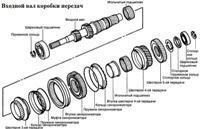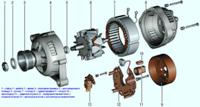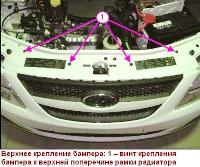In the previous article, we examined the decoding of codes DF001 to DF072 for the Renault Megan-2 gasoline engine
Continue:
DF073 Cylinder 2 ignition coil circuit
The cause of the malfunction: - an open circuit or a short to ground
If faults DF046, DF084 or DF085 are present or stored, deal with them first.
If the Cylinder #3 Ignition Coil Circuit fault is also present or stored, treat it first.
Requirements for diagnostics for a stored fault:
- - The fault is declared present after running the starter for 10 seconds or after holding for 10 seconds with the engine running.
Disconnect the cylinder #2 finger type ignition coil connector.
Check the cleanliness and condition of the finger coil and its connector.
Check the resistance of the primary and secondary windings of the cylinder 2 finger-type ignition coil (see "Element resistance table" for values).
If the values are out of range, then replace the finger-type ignition coil.
Disconnect the battery and the injection computer.
Check the cleanliness of the contacts and the condition of the connector.
Connect the universal contact board instead of the ECU and check for open circuits and short circuits in the circuit:
ECU terminal M3, connector C ► Cylinder 2 ignition coil
Cylinder #3 Ignition Coil ► Cylinder #2 Ignition Coil (See connector pin number on related wiring diagram).
If the problem persists, replace the defective finger-type ignition coil.
If the problem persists, handle other problems and then proceed to compliance.
After troubleshooting, delete the information from memory.
DF074 Cylinder 3 ignition coil circuit
The cause of the malfunction: - an open circuit or a short to ground
Disconnect the cylinder #3 finger type ignition coil connector.
Check the cleanliness and condition of the finger coil and its connector.
Check the resistance of the primary and secondary windings of the cylinder 3 finger type ignition coil (see "Element resistance table" for values).
If the values are out of range, then replace the finger-type ignition coil.
Disconnect the battery and the injection computer.
Check the cleanliness of the contacts and the condition of the connector.
Connect the universal contact board instead of the ECU and check for open circuits and short circuits in the circuits:
Cylinder #3 ignition coil ► Cylinder #2 ignition coil
ECU, channel M3, connector C ► Ignition coil for cylinder #2 (see connector pin numbers on the appropriate wiring diagram).
With the card installed in the reader in the 2nd fixed position, check for + 12 V at the ignition coil connector of the pencil type cylinder No. 3 (see the pin number of the connector on the corresponding wiring diagram).
If there is no +12V voltage:
- - disconnect the battery,
- - disconnect the connector marked PPM2 in the protection and switching unit,
- – check the cleanliness of the contacts and the condition of the connector,
- - connect the universal contact board. Make sure there is no open in the following circuit:
Protection and switching unit, connector PPM1 track 8 Finger type ignition coil, cylinder #3
Connect the connector of the protection and switching unit and connect the battery.
If, with the card in the reader in the 2nd fixed position, + 12 V voltage is still not supplied to the ignition coil connector of cylinder No. 3, this indicates a malfunction in the protection and switching unit.
If the problem persists, replace the defective finger-type ignition coil.
If the problem persists, handle other problems and then proceed to compliance.
After troubleshooting:
Follow "Diagnostic conditions for stored fault":
- – If the fault is present, continue handling the fault.
- - If the fault is stored, don't take it into account anymore.
Deal with other possible problems.
Clear fault information from memory.
DF075 Cylinder 4 ignition coil circuit
Disconnect the #4 cylinder finger ignition coil connector.
Check the cleanliness and condition of the finger coil and its connector.
Check the resistance of the primary and secondary windings of the cylinder #4 finger type ignition coil (see "More Information" for values).
If the values are out of range, then replace the finger-type ignition coil.
Disconnect the battery and ECU ryska.
Check the cleanliness of the contacts and the condition of the connector.
Connect the universal contact board instead of the ECU and check for open circuits and short circuits in the circuits:
Cylinder #4 ignition coil ► Cylinder #1 ignition coil
ECU, channel M4, connector C ► Ignition coil for cylinder #1 (see connector pin numbers on the appropriate wiring diagram).
With the card installed in the reader in the 2nd fixed position, check for + 12 V at the connector of the finger-type ignition coil of cylinder No. 4 (see the pin number of the connector on the corresponding wiring diagram).
If there is no +12V voltage:
- - disconnect the battery,
- - disconnect the connector marked PPM2 in the protection and switching unit,
- – check the cleanliness of the contacts and the condition of the connector,
- - connect the universal contact board. Make sure there is no open in the following circuit:
Protection and switching unit, connector PPM1 pin 8 ► Finger type ignition coil, cylinder #4
Connect the connector of the protection and switching unit and connect the battery.
If, with the card in the reader in the 2nd fixed position, + 12 V voltage is still not supplied to the ignition coil connector of cylinder No. 4, this indicates a malfunction in the protection and switching unit.
If the problem persists, replace the defective finger-type ignition coil.
If the problem persists, handle other problems and then proceed to compliance.
Follow "Diagnostic conditions for stored fault":
- – If the fault is present, continue handling the fault.
- - If the fault is stored, don't take it into account anymore.
Deal with other possible problems.
Clear fault information from memory.
DF078 Servo Throttle Control Circuit
Failure cause: - short circuit to + 12 V;
- - General Motorized Throttle Control Fault
If faults DF095 or DF096 are present, deal with them first.
Requirements for diagnostics for a stored fault:
The fault is declared present after changing the engine speed.
Air temperature should be between 5 - 105 °C.
IMPORTANT NOTICE: Never operate the vehicle until you have verified that there are no problems with the throttle body.
Check the cleanliness and condition of the throttle body and its connector.
Check that the throttle is free to turn by hand.
Disconnect the battery and the injection computer.
Check the cleanliness of the contacts and the condition of the connector.
Connect the universal contact board instead of the ECU and check for open circuits and short circuits in the circuits:
ECU channel M3, connector B ► Motorized throttle body
ECU channel M4, connector B ► Motorized throttle body
ECU channel G4, connector B ► Motorized throttle body
(See the connector pin numbers on the relevant wiring diagram).
Check the electrical resistance of the throttle motor by measuring on terminals M3 and M4 of the computer connector (see "Additional Information" for the value).
If the value is not correct, replace the throttle body.
If the problem persists, handle other problems and then proceed to compliance.
After troubleshooting:
Reprogram ("RZ008") if the throttle body has been replaced.
Follow "Diagnostic conditions for stored fault":
- – If the fault is present, continue handling the fault.
- - If the fault is stored, don't take it into account anymore.
Treat other possible problems. Clear fault information from memory.
DF079 Motorized Throttle Follower System
Causes: - Malfunction of determining the extreme positions of the throttle;
- - Error in programming the initial position of the servo throttle;
- - Throttle actuator malfunction;
- - Throttle valve is not set to the programmed position
If faults DF078, DF095 or DF096 are present or stored, deal with them first.
Requirements for diagnostics for a stored fault:
The fault is declared present after changing the engine speed.
The air temperature shouldbe within 5 - 105°C.
IMPORTANT NOTICE: Never operate the vehicle until you have verified that there are no problems with the throttle body.
Check the cleanliness and condition of the throttle body and its connector.
Check that the throttle is free to turn by hand.
Disconnect the battery and the injection computer.
Check the cleanliness of the contacts and the condition of the connector.
Connect the universal contact board, check for open and short circuits in the following circuits:
- ECU channel M3, connector B ► Motorized throttle body
- ECU channel M4, connector B ► Motorized throttle body
- ECU channel G4, connector B ► Motorized throttle body
- ECU channel G3, connector B ► Throttle position sensor, track 1
- ECU channel G2, connector B ► Throttle position sensor, track 1
- ECU channel D3, connector B ► Throttle position sensor, track 2
- ECU channel G2, connector B ► Throttle position sensor, track 2
(See the connector pin numbers on the relevant wiring diagram).
If fault DF011 is present or stored, deal with the fault.
Check the resistance of the throttle actuator motor by measuring on terminals M3 and M4 (see "More information" for the value).
If the value is not correct, replace the throttle body.
If the problem persists, handle other problems and then proceed to compliance.
AFTER REPAIR
Reprogram ("RZ008") if the throttle body has been replaced.
Follow "Diagnostic conditions for stored fault":
- – If the fault is present, continue handling the fault.
- - If the fault is stored, don't take it into account anymore.
Treat other possible problems. Clear fault information from memory.
DF080 Camshaft dephaser solenoid valve circuit
Failure causes: - Open circuit
- - Short circuit to ground.
- - Short circuit to + 12V
- - Offset of programmed values
- - Mismatch of programmed values
- - Error in determining the position of the camshaft phase regulator
- - Phase regulator regulation values out of tolerance
If faults DF046 or DF084 are present or stored, deal with them first. Conditions for carrying out diagnostics for a stored fault:
The fault is declared present after changing the engine speed.
Check the cleanliness and condition of the camshaft dephaser solenoid valve connections.
Check the resistance of the camshaft dephaser solenoid valve (value see "Additional Information").
If the value is not correct, replace the camshaft dephaser solenoid valve.
With the card installed in the reader in the 2nd fixed position, check for + 12 V voltage at the camshaft dephaser solenoid valve connector (see the connector pin number on the corresponding wiring diagram).
If there is no +12V voltage:
- - disconnect the battery,
- - disconnect the connector marked PPM1 in the protection and switching unit,
- – check the cleanliness of the contacts and the condition of the connector,
- - connect the universal contact board. Make sure there is no open in the following circuit:
Protection and switching unit, PPM1 connector ► pin 1 Camshaft dephaser solenoid valve
Connect the connector of the protection and switching unit and connect the battery.
If with the card installed in the reader in the 2nd fixed position,
Voltage + 12 V is still not supplied to the solenoid valve connector of the camshaft dephaser, this indicates a malfunction in the protection and switching unit.
Disconnect the battery.
Disconnect the computer from the on-board network. Check the cleanliness of the contacts and the condition of the connector.
Connect the universal terminal board. Check for open circuits and short circuits in the circuit:
ECU, channel L3, connector B ► Camshaft dephaser solenoid valve (refer to the corresponding wiring diagram for connector pin numbers).
If the problem persists, deal with other problems and then go to contact matching role.
AFTER REPAIR
Follow "Diagnostic conditions for stored fault":
- – If the fault is present, continue handling the fault.
- - If the fault is stored, don't take it into account anymore.
Treat other possible problems. Clear fault information from memory.
DF081 Canister Purge Solenoid Valve Circuit
Failure causes: - Open circuit;
- - Short circuit to ground;
- - Short circuit to + 12 V.
If faults DF046 or DF084 are present or stored, deal with them first.
Requirements for diagnostics for a stored fault:
The fault is declared present after inserting the card into the reader in the 2nd fixed position.
Check the cleanliness and condition of the connections of the canister purge solenoid valve and its connector.
Check the resistance of the canister purge solenoid valve (see "More Information" for the value).
If the resistance value is not correct, replace the canister purge solenoid valve.
With the card installed in the reader in the 2nd fixed position, check for + 12 V voltage at the connector of the canister purge solenoid valve (see the connector pin number on the corresponding wiring diagram).
If there is no +12V voltage:
- - disconnect the battery,
- - disconnect the connector marked PPM1 in the protection and switching unit,
- – check the cleanliness of the contacts and the condition of the connector,
- - connect the universal contact board. Make sure there is no open in the following circuit:
Protection and switching unit, PPM1 connector pin 2 Canister purge solenoid valve
Connect the connector of the protection and switching unit and connect the battery.
If, with the card installed in the reader in the 2nd fixed position, + 12 V voltage is still not supplied to the connector of the canister purge solenoid valve, this indicates a malfunction in the protection and switching unit.
Disconnect the battery.
Disconnect the computer from the on-board network. Check the cleanliness of the contacts and the condition of the connector.
Connect the universal contact board. Check for open circuits and short circuits in the circuit:
ECU, channel E1, connector C Canister purge solenoid valve (see the corresponding wiring diagram for connector pin numbers).
If the problem persists, handle other problems and then proceed to compliance.
AFTER REPAIR
Follow "Diagnostic conditions for stored fault":
- – If the fault is present, continue handling the fault.
- - If the fault is stored, don't take it into account anymore.
Treat other possible problems. Clear fault information from memory.
DF082 upstream oxygen sensor heating circuit
Failure causes: - Open circuit;
- - Short circuit to ground;
- - Short circuit to + 12 V.
If faults DF046 or DF084 are present or stored, deal with them first.
Requirements for diagnostics for a stored fault:
The fault is declared present after a delay of 10 seconds with the engine running.
Check the cleanliness and condition of the upstream oxygen sensor connector.
With the card installed in the reader in the 2nd fixed position, check for + 12 V at the upstream oxygen sensor connector (see connector pin number on the corresponding wiring diagram).
If there is no +12V voltage:
- - disconnect the battery,
- - disconnect the connector marked PPM1 in the protection and switching unit,
- – check the cleanliness of the contacts and the condition of the connector,
- - Connect the universal terminal board, check the continuity of the following circuit:
Protection and switching unit, connector PPM1 track 2 Upstream oxygen sensor
Connect the connector of the protection and switching unit and connect the battery.
If with the card installed in the reader in the 2nd fixed position,
Voltage + 12 V is still not supplied to the connector of the upstream oxygen sensor, this indicates a malfunction in the protection and switching unit.
Disconnect the battery and the injection computer.
Check the cleanliness of the contacts and the condition of the connector.
Connect the universal terminal board. Check for open circuits and short circuits in the circuit:
E Control unit, pin L2, connector C ► Upstream oxygen sensor (See the corresponding wiring diagram for connector pin number).
Check the resistance of the upstream oxygen sensor heating element. (see "More information" for the meaning).
If the value is not correct, replace the upstream oxygen sensor.
If the problem persists, handle other problems and then proceed to compliance.
AFTER REPAIR
Follow "Diagnostic conditions for stored fault":
- – If the fault is present, continue handling the fault.
- - If the fault is stored, don't take it into account anymore.
Treat other possible problems. Clear fault information from memory.










